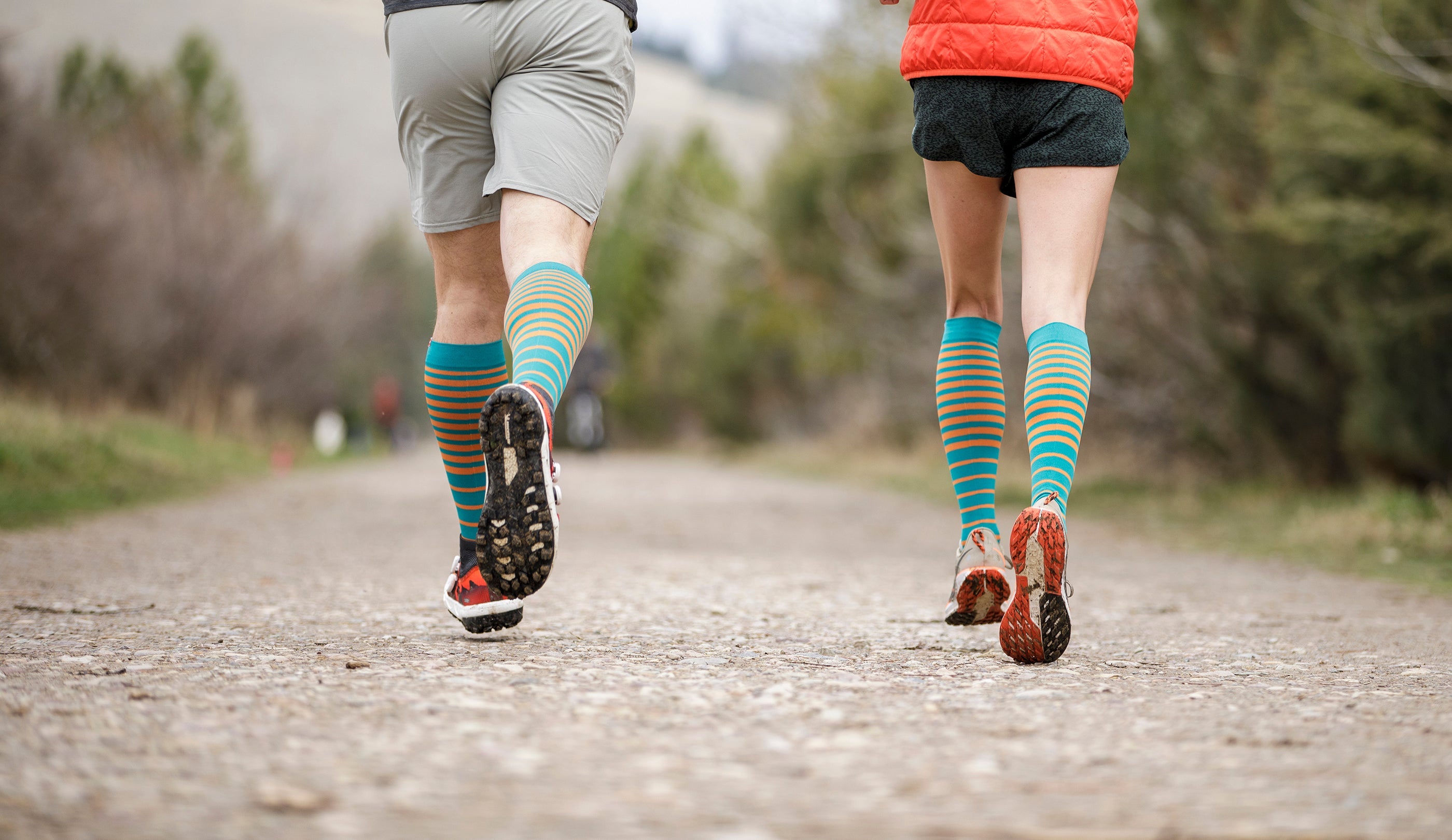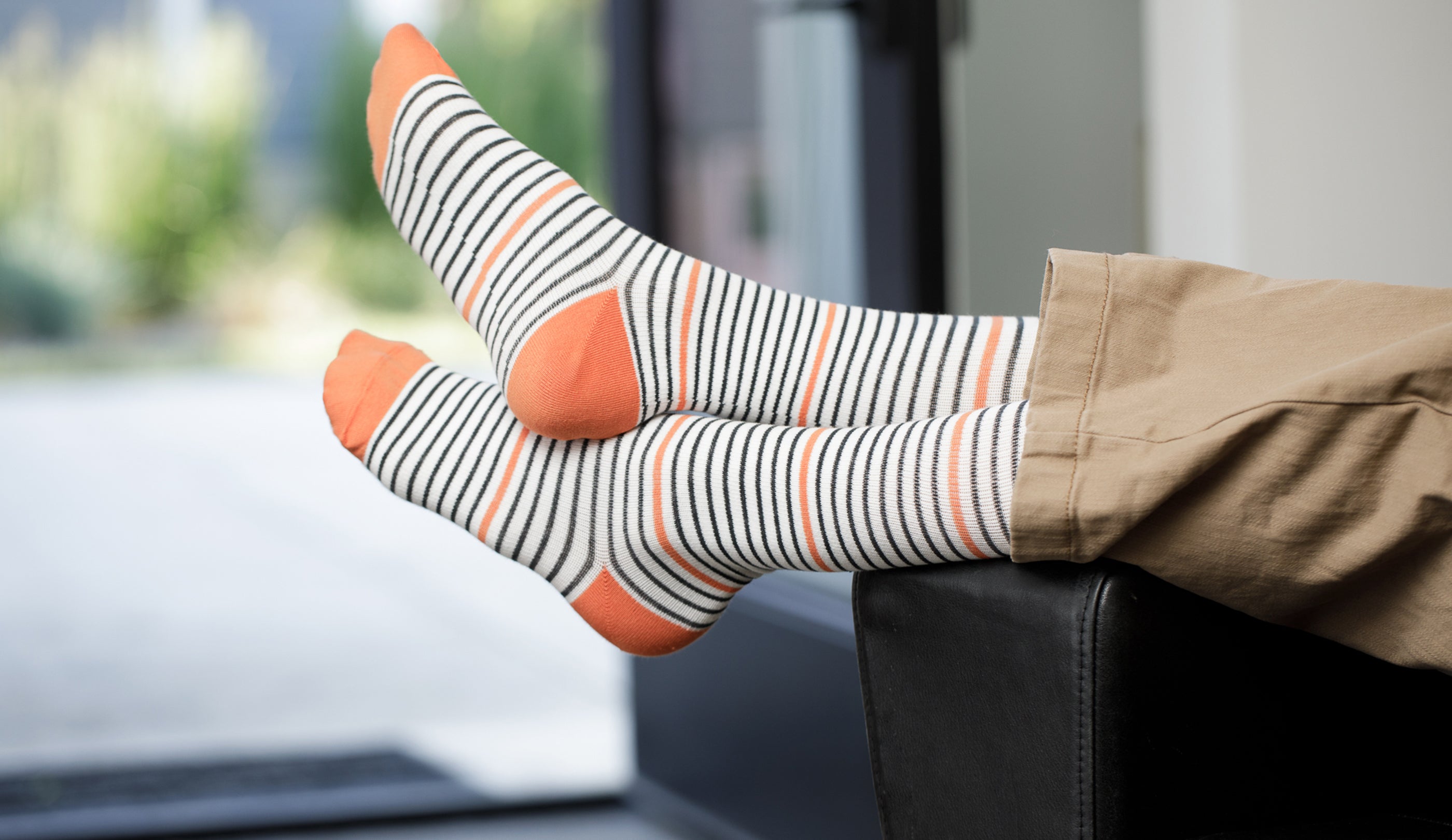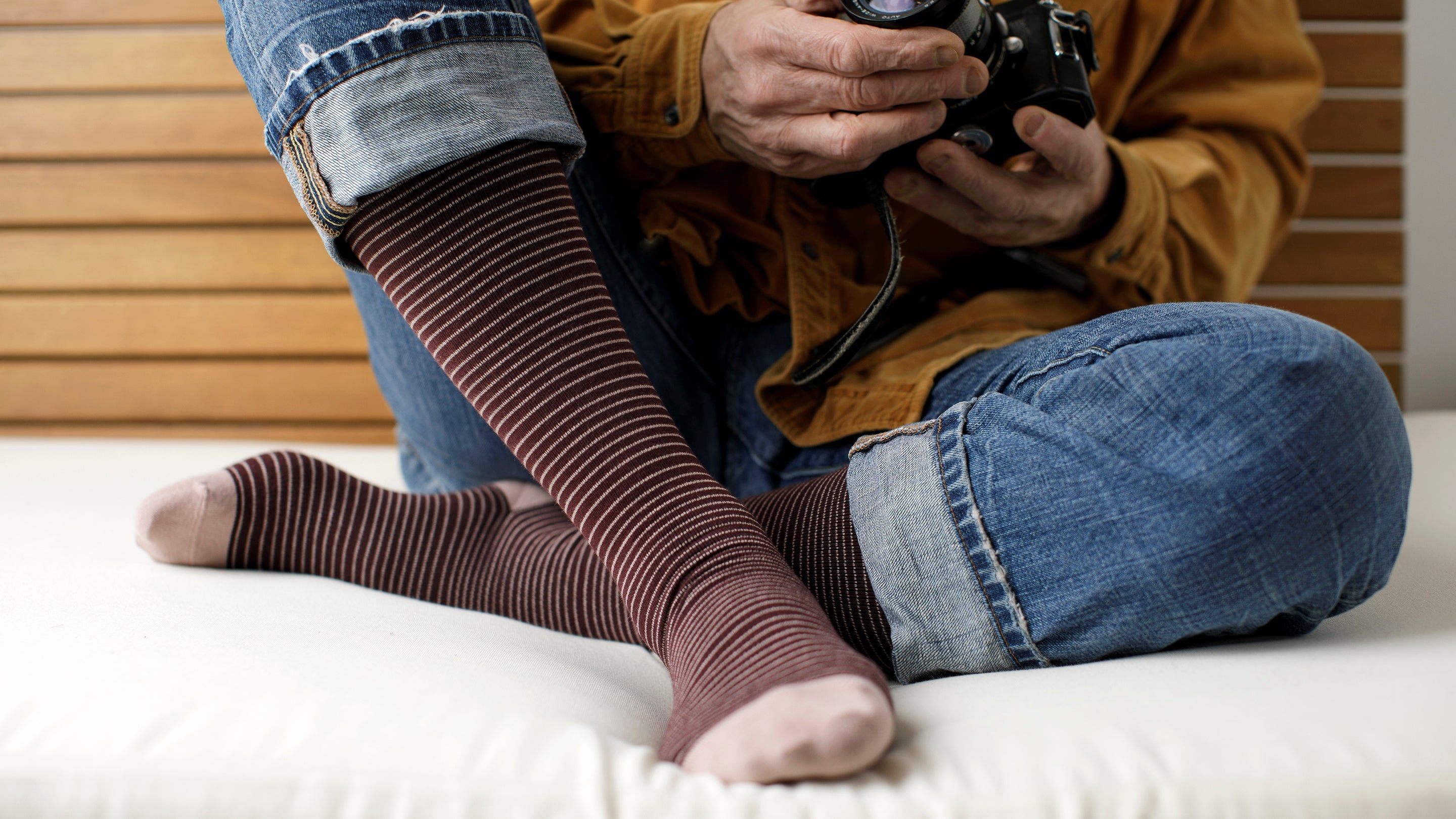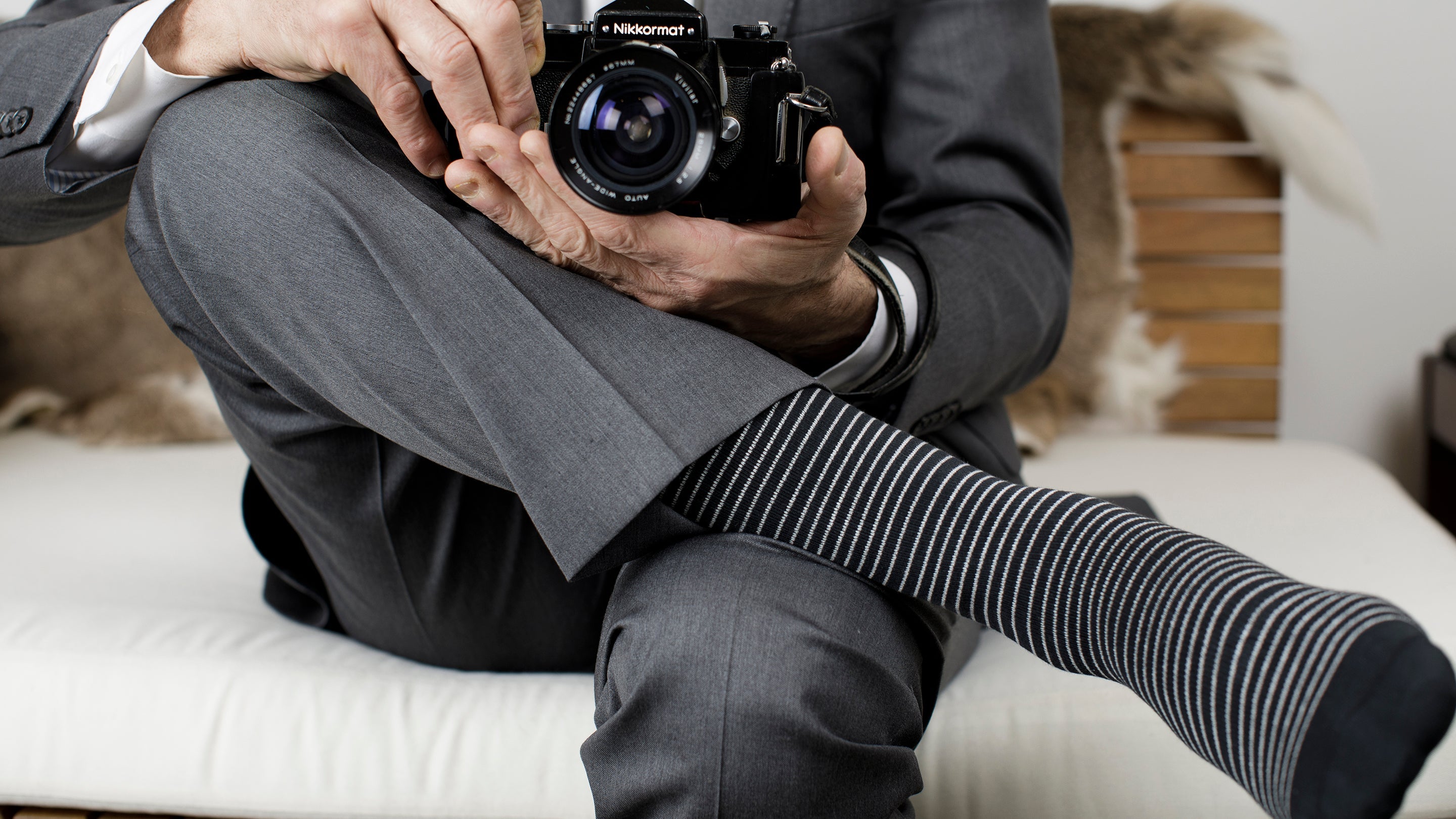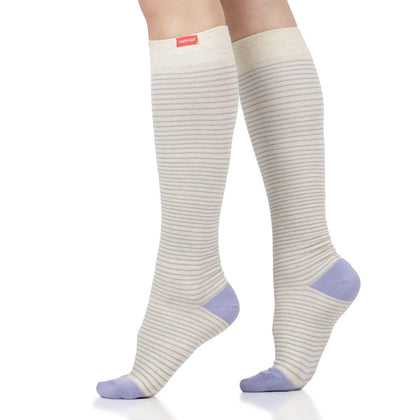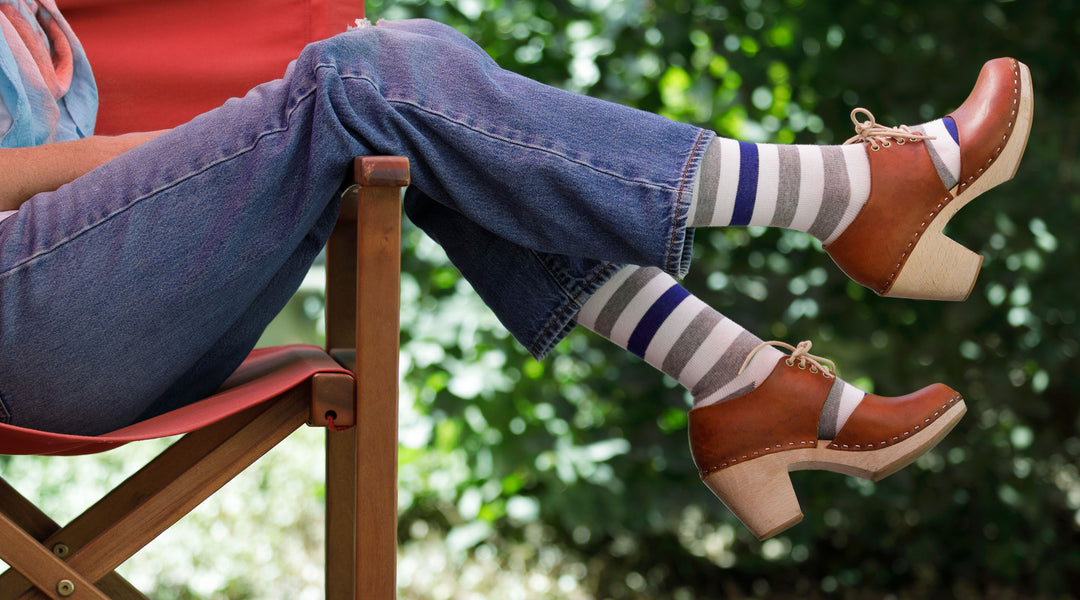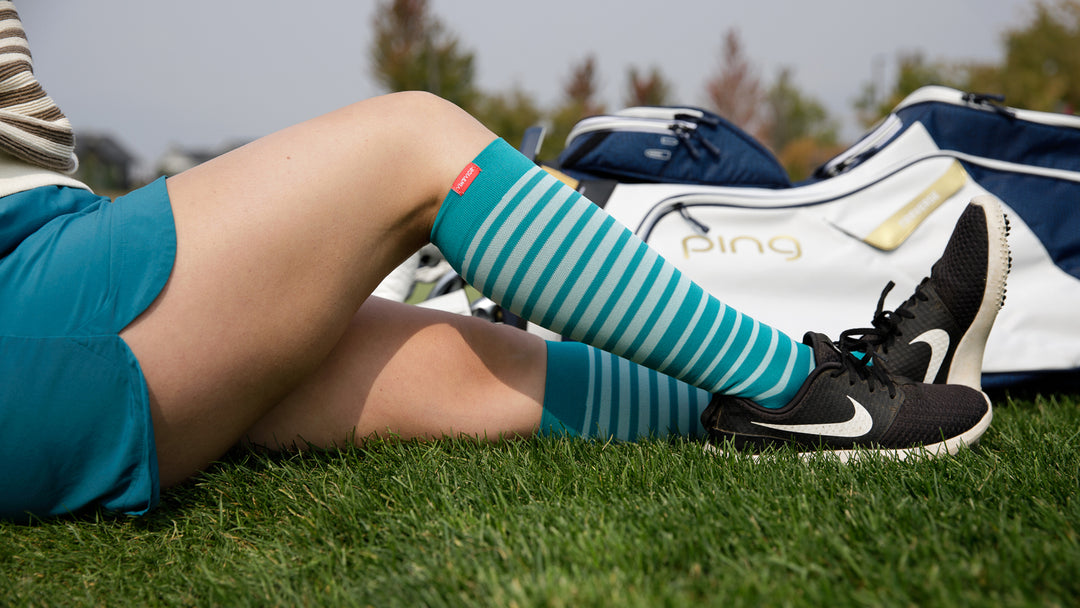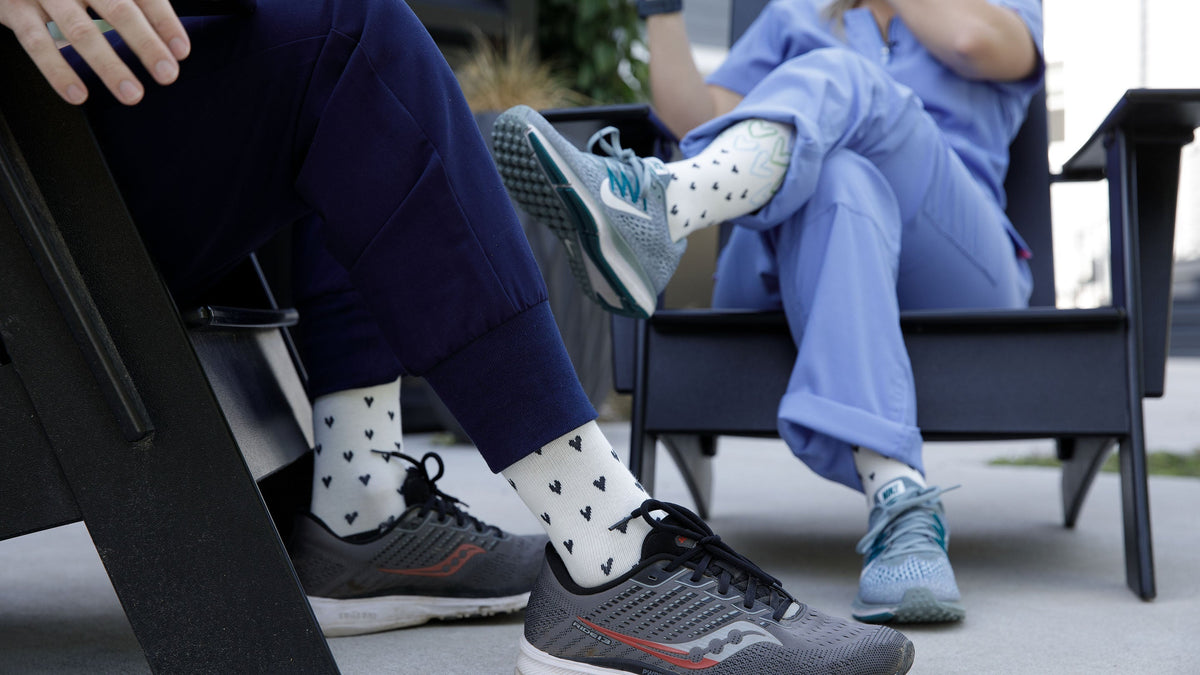

Nurses and healthcare professionals are on their feet for long periods of time every day, often for 12-hour shifts. This can cause problems with healthy blood circulation, which leads to an increased risk of swelling, pain, and inflammation of the legs. Nurses are also at risk of developing serious problems like high oxidative stress that can trigger venous insufficiency, or foot injuries.
Graduated compression socks apply therapeutic pressure on the lower legs, supporting the muscles and joints and stimulating upwards blood flow. This makes them a nurse’s best friend because medical experts discovered that graduated compression legwear boosts peripheral circulation and alleviates blood flow problems in the legs. Compression socks may also offer added stability and stress relief for the joints and feet.
Read on to find out why nurses wear compression socks and the benefits these garments can have for all healthcare professionals who stand for long hours at work.

Explore popular compression socks styles designed for fashion and comfort during every shift
Why Do Nurses Wear Compression Socks?
During long, multi-hour shifts, nurses spend most of their time on their feet — either standing or walking. This places significant strain on the lower legs and blood vessels, which increases the risk of circulatory problems as well as foot and ankle injuries per one scientific review. Compression socks can relieve some of this stress while boosting peripheral blood flow, reducing the risk of medical conditions such as edema, blood clots, or deep vein thrombosis.
Through therapeutic pressure and circulatory support, compression socks have been reported to reduce fatigue and help re-energize the legs. This helps with overall energy levels in a demanding job, where alertness is critical.
Finally, compression socks offer a welcome relief after a long day spent on your feet. Studies show that compression socks and stockings can help muscles recover faster and reduce inflammation and swelling. This makes them a fantastic recovery tool for nurses who have been standing for their whole workday.
Why Are Compression Socks Good for Nurses?
Vim & Vigr compression socks are graduated — they are tighter at the ankles and gradually looser towards the knee. This helps stimulate circulation of blood out of the legs, preventing gravity from pushing blood down and causing it to pool around the ankles. For nurses, who spend most of their time on their feet, graduated compression is essential for preventing swelling, discomfort, and conditions like varicose veins. Studies on security guards who stand for entire 8-hour shifts found that wearing graduated compression legwear can reduce long-lasting muscle fatigue, edema, and discomfort. This improved the quality of life for those staff as well as comfort and efficiency at work.
Nurses are at higher risk of developing circulatory problems because they are constantly standing. Because of this, nurses are at a higher risk of developing varicose veins, blood clots, and more. One study even found that nurses were prone to developing cardiovascular disease, which is mainly due to the high-stress of caretaking and intense work environments. Therefore, taking any step to enhance circulatory system health is crucial for their wellbeing, and graduated compression legwear is a good support tool.
Furthermore, compression socks support the lower leg muscles, reducing the impact of standing and walking during a nurse’s shift. The micro-vibrations that these muscles would normally register are reduced, which makes nurses suffer less from muscle damage and fatigue. This keeps them more comfortable and alert during work, and less likely to experience soreness and discomfort throughout work and at home.
Finally, wearing compression socks is also linked to increased balance and stability, particularly for individuals who are on their feet a lot. The tight grip from graduated compression socks is reassuring and guiding, ideal for wearing after you’re coming back from injury. Thus, this is an excellent choice for nurses who work while standing throughout long shifts every day.

The Benefits of Wearing Compression Socks for Nurses
Thanks to their graduated design, Vim & Vigr compression socks bring lots of benefits to nurses who spend their time on their feet. They support healthy circulation, reduce swelling and discomfort, reduce the risk of certain medical conditions, and improve energy levels.
Improving Blood Circulation
Through the therapeutic pressure applied to the lower legs, compression socks stimulate venous return and increase local blood flow. Graduated compression socks particularly help push the blood out of the veins in the feet and ankles, which reduces swelling and discomfort. Additionally, better peripheral blood flow may contribute to improved wellbeing and a healthy circulatory system, which could reduce the risk of painful circulatory system problems.
Reducing Swelling and Discomfort
Looking particularly at nursing students, one study has reported that wearing compression socks reduces swelling and discomfort. The researchers found that knee-high compression socks delivered results that were as effective as stockings. Wearing compression legwear allowed the nursing students to experience less pain and improve their work satisfaction.
After a long day, compression socks can deliver relief from pain and swelling. They have been reported to help speed up recovery of the lower leg muscles in athletes, which could help any nurse’s leg muscles relax and feel re-energized for the next shift.
Preventing Varicose Veins and Spider Veins
When the lower leg veins struggle to send blood back to the heart, blood can pool in the veins and stretch them. Stretched veins become gradually weaker and can lead to damaged valves that create varicose veins. Working on your feet for extended periods is a major risk factor for developing varicose veins and spider veins (the appearance of red, blue, or purple lines from damaged blood vessels in the skin).
Compression garments boost localized blood flow and prevent fluid pooling, thereby reducing pressure on the veins. This is why compression socks are a great ally for nurses, construction workers, or hairdressers.
Reducing the Risk of Deep Vein Thrombosis
Compression socks increase circulation and prevent blood from pooling at the extremities, limiting the creation of blood clots or of developing varicose veins and minimizing the risk of deep vein thrombosis (DVT). This condition is triggered when a blood clot forms in one or more of the deep veins, most often in the legs. It is dangerous, with potentially fatal consequences. Maintaining a healthy, continuous blood flow throughout the body and particularly in the legs is therefore essential for nurses.
Fighting Fatigue and Boosting Energy
One study found that nurses can walk around 4-5 miles during a 12-hour shift. Beyond walking, however, simply standing for long periods of time takes its toll on the body, particularly the lower leg muscles. As a result, nurses may start to feel fatigued and have a lack of energy while they cope with sore legs and feet. This is obviously not what you want nurses to experience during their working hours!
Through a combination of increasing peripheral blood flow and supporting and massaging the lower leg muscles, compression socks reduce feelings of pain or soreness, which may reduce fatigue. As a result, graduated compression socks can contribute to better energy and focus levels for nurses during their shift.

How Compression Socks Fit Into a Nurse’s Routine
Good-quality compression socks can benefit nurses at all times of their day: before, during, and after shifts. Wearing them after shifts provides a soothing leg massage and improved circulation for better recovery. Before and during shifts, nurses will feel more supported, with a boost in blood flow and a warming up of the muscles that can prevent strains and sprains while working.
Starting Your Shift Off Right
If you already have poor peripheral circulation, or your legs are tired and swollen from the day before, you’re not going to feel much better during your next shift. In fact, the gravitational pressure on your lower leg veins will simply add up and make you more likely to suffer from edema and pain. One study on nursing students agreed that the simple fact of spending time on your feet leads to all these risks, and that knee-high compression socks are a great way to prevent the onset of pain and blood pooling.
Before your shift, spend some time in your favorite pair of compression socks to “warm up” the muscles and get blood flowing freely. You’re likely to feel lighter and more energized even before you start work. All it takes is two to three hours wearing your socks, which you can keep on during your shift for best results.
Additionally, develop a pre-shift routine and adopt a few of the night shift top tips we’ve put together for you here.
Post-Shift Recovery
After a long day on your feet, releasing pressure on the lower limbs must be a priority. We recommend putting your feet up, as leg elevation already takes the pressure off the feet, releases muscle tension, and facilitates upward blood flow. This will help bring down the swelling, too.
Put on a pair of 20-30 mmHg compression socks to increase blood flow and massage your lower legs at the same time. You can wear them while you relax on the couch, but also into the evening or when going out. Vim & Vigr graduated compression socks come in so many colors and designs, that you can match with pretty much any outfit!
Everyday Comfort
Compression socks are safe to wear for as long as you feel comfortable and on an everyday basis, too (not just during your shift!). We recommend starting off with 15-20 mmHg (the lightest pressure level) and wearing them for a few hours the first time, before getting used to the feeling of compression. Remember to check with your doctor if you have any pre-existing health conditions or concerns.
In addition to compression socks, here are some other ways in which nurses can care for their legs:
Wear comfortable shoes, with adequate padding and arch support
Take cold or hot baths for the feet when returning from a long shift (both cold and hot therapy can help boost circulation and soothe the feet, it’s a matter of personal preference)
Ensure you program in some breaks to sit down and relax during your shift - as much as possible
Elevate your legs when resting at home (putting them on a cushion can work well)
Foot massages

What Compression Level Should Nurses Wear?
Nurses can benefit from varying levels of graduated pressure. We usually recommend that you start with 15-20 mmHg compression and work your way up to 20-30 mmHg compression if you need more support. The key is to find the socks that feel comfortable when you wear them for long stretches of time, since you want to be able to continue with your day without discomfort or long-term health implications.
A sock pressure of 15-20 mmHg is great to start with, because it gives a gentle “squeeze” to your legs all day long, without becoming “too much.” Many nurses prefer this level of compression thanks to its light, yet effective pressure. This is also preferable if you don’t suffer from any circulatory problems. However, those nurses who have pre-existing conditions (e.g., varicose veins) may want to try 20-30 mmHg compression socks from the start.
Comparing Fabric Options
One important part of picking the best compression socks for nurses is to find the right fabric. Your environment, weather conditions, and personal preferences will all play a part in how comfortable your socks are.
Vim & Vigr compression socks come in three different fabrics specifically for this reason:
Cotton for everyday wear and neutral temperature conditions. Cotton is soft and breathable, pairing well with walking shoes used by nurses on their shifts. However, it’s not great for moisture-wicking, so in humid conditions, you should pick nylon or merino wool.
Nylon is flexible and sleek, moving with your body to a level you won’t even know you’re wearing socks. We offer moisture-wicking nylon specifically for hot conditions and, if you’re sensitive to seams and rubbing, you can even choose our “seamless toe” designs.
Merino wool is very soft, comfortable, and versatile. It will keep your feet warm and dry in winter, but it’s also great at letting them breathe and cool down in summer. We recommend it for people with sensitive skin, too, since it’s hypoallergenic and antibacterial.

Not sure which fabric fits your day? Explore our breathable, comfort-focused picks
Compression Sock Styles for Nurses
When you spend long shifts on your feet, supporting good circulation is essential for your overall health and wellbeing, but also for comfort and energy levels. When blood flows freely through the leg veins and back up towards the heart, the risk of swelling, discomfort, and complications like varicose veins decreases. This is why nurses favor graduated compression socks for their everyday comfort, but also for preventing health issues over the longer term.
Vim & Vigr compression socks are all graduated, designed in such a way that they stimulate blood flow up towards the heart. They support the leg veins and help ensure blood flow is optimized throughout the body. Also, they soothe the muscles, supporting the joints and providing stability and more energy for lots of walking and standing during your nursing shift.
Find compression that works as hard as you do: shop by your perfect level of support
References
Bernardes, R. A., Caldeira, S., Parreira, P., Sousa, L. B., Apóstolo, J., Almeida, I. F., Santos-Costa, P., Stolt, M., & Guardado Cruz, A. (2023). Foot and Ankle Disorders in Nurses Exposed to Prolonged Standing Environments: A Scoping Review. Workplace health & safety, 71(3), 101–116. Read it here.
Flore, R., Gerardino, L., Santoliquido, A., Catananti, C., Pola, P., & Tondi, P. (2007). Reduction of oxidative stress by compression stockings in standing workers. Occupational medicine (Oxford, England), 57(5), 337–341. Read it here.
Jakovljevic, V., Djuric, D., Pechanova, O., Bolevich, S., & Tyagi, S. (2020). Oxidative Stress and Cardiovascular Dysfunction: From Basic Science to Applied Investigations. Oxidative medicine and cellular longevity, 2020, 6985284. Read it here.
Lee, Y., Kim, K., Kang, S., Kim, J. Y., Kim, S. G., Kim, T., & Jung, J. (2020). Compression Stocking Length Effects on Oedema, Pain, and Satisfaction in Nursing Students: A Pilot Randomized Trial. Healthcare (Basel, Switzerland), 8(2), 149. Read it here.
Mota, G. R., Simim, M. A. M., Dos Santos, I. A., Sasaki, J. E., & Marocolo, M. (2020). Effects of Wearing Compression Stockings on Exercise Performance and Associated Indicators: A Systematic Review. Open access journal of sports medicine, 11, 29–42. Read it here.
O'Riordan, S. F., Bishop, D. J., Halson, S. L., & Broatch, J. R. (2022). Compression-induced improvements in post-exercise recovery are associated with enhanced blood flow, and are not due to the placebo effect. Scientific reports, 12(1), 16762. Read it here.
Sachdeva, A., Dalton, M., & Lees, T. (2018). Graduated compression stockings for prevention of deep vein thrombosis. The Cochrane database of systematic reviews, 11(11), CD001484. Read it here.
Sun, Y., Munro, B., & Zehr, E. P. (2021). Compression socks enhance sensory feedback to improve standing balance reactions and reflex control of walking. BMC sports science, medicine & rehabilitation, 13(1), 61. Read it here.
Waters, T. R., & Dick, R. B. (2015). Evidence of health risks associated with prolonged standing at work and intervention effectiveness. Rehabilitation nursing: the official journal of the Association of Rehabilitation Nurses, 40(3), 148–165. Read it here.
Welton, J. M., Decker, M., Adam, J., & Zone-Smith, L. (2006). How far do nurses walk? Medsurg nursing: official journal of the Academy of Medical-Surgical Nurses, 15(4), 213–216. Read it here.
